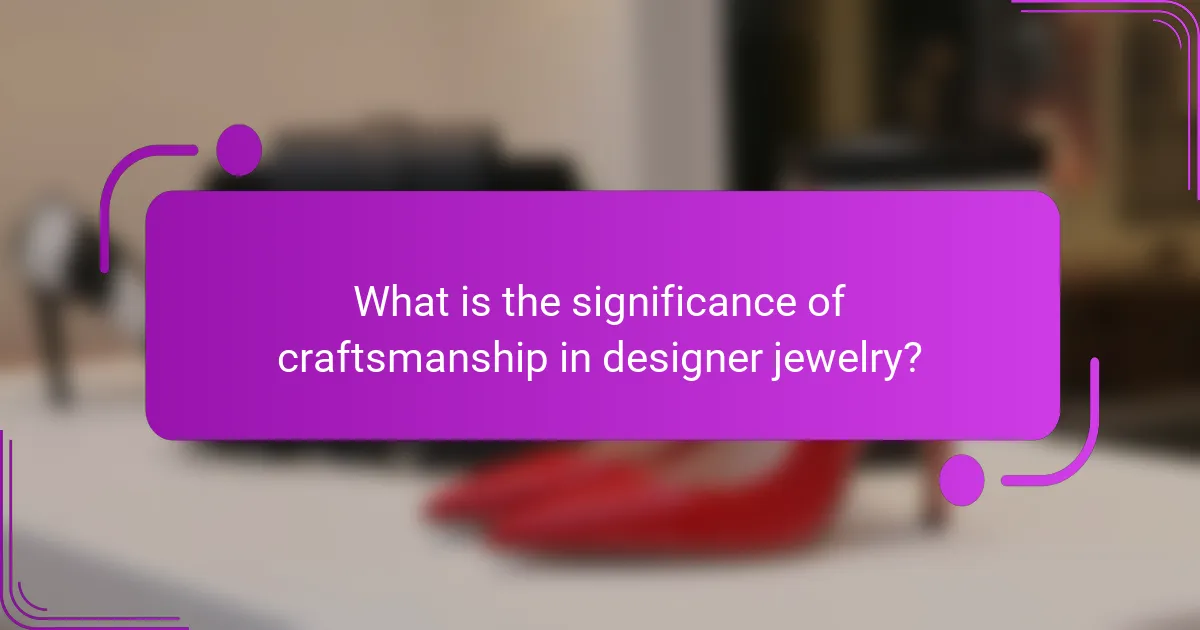Craftsmanship is a critical factor influencing the value of designer jewelry, as it directly impacts quality, uniqueness, and aesthetic appeal. High-quality craftsmanship involves intricate designs and precise detailing, which enhance durability and longevity. Additionally, design elements such as shape, color, texture, and materials significantly contribute to the overall value of jewelry pieces. Economic factors, including market demand, production costs, and brand reputation, further affect pricing and perceived value in the competitive jewelry market. Understanding these components is essential for grasping how craftsmanship shapes the designer jewelry landscape.

What is the significance of craftsmanship in designer jewelry?
Craftsmanship is crucial in designer jewelry as it determines quality and uniqueness. High-quality craftsmanship results in intricate designs and precise detailing. This attention to detail enhances the overall aesthetic appeal. Skilled artisans use superior materials, which increases durability and longevity. The craftsmanship also influences the brand’s reputation and perceived value. For example, renowned designers often command higher prices due to their exceptional craftsmanship. This creates a sense of exclusivity and desirability among consumers. Ultimately, craftsmanship plays a vital role in distinguishing designer jewelry in a competitive market.
How does craftsmanship influence the overall value of designer jewelry?
Craftsmanship significantly influences the overall value of designer jewelry. High-quality craftsmanship ensures precision and attention to detail in each piece. This level of skill often results in unique designs that stand out in the market. For instance, intricate handwork can elevate a piece’s aesthetic appeal, making it more desirable to consumers. Additionally, craftsmanship impacts the durability and longevity of jewelry, which are critical factors for buyers. Jewelry made with superior techniques often retains its value over time. According to a 2020 study by the Gemological Institute of America, pieces with exceptional craftsmanship can appreciate in value by up to 30% over a decade. Thus, craftsmanship is a key determinant of both immediate and long-term value in designer jewelry.
What specific craftsmanship techniques are commonly used in designer jewelry?
Common craftsmanship techniques used in designer jewelry include hand engraving, stone setting, and metalworking. Hand engraving involves carving intricate designs into the metal surface. This technique enhances the aesthetic appeal and uniqueness of each piece. Stone setting secures gemstones in place, using methods like prong, bezel, or pave settings. Each method affects the visual impact and durability of the jewelry. Metalworking encompasses techniques such as forging, soldering, and casting. These processes shape and join metals, allowing for creative designs and structural integrity. Collectively, these techniques contribute to the overall quality and value of designer jewelry.
How do these techniques differentiate designer jewelry from mass-produced items?
Designer jewelry is differentiated from mass-produced items through unique craftsmanship techniques. These techniques include handcrafting, custom designs, and the use of high-quality materials. Handcrafting allows for intricate details that are often impossible to replicate in mass production. Custom designs cater to individual tastes, ensuring exclusivity. High-quality materials, such as ethically sourced gemstones and precious metals, enhance the overall value. According to the Gemological Institute of America, designer pieces often feature superior craftsmanship, which contributes to their higher market value. This combination of artistry and quality sets designer jewelry apart from mass-produced alternatives.
Why is the quality of materials important in designer jewelry craftsmanship?
The quality of materials is crucial in designer jewelry craftsmanship because it directly affects durability and aesthetic appeal. High-quality materials ensure that the jewelry can withstand wear and tear over time. For instance, precious metals like gold and platinum resist tarnishing and corrosion. Additionally, gemstones with superior clarity and cut enhance the overall beauty of the piece. The use of premium materials also reflects the designer’s commitment to excellence. This commitment can lead to higher market value and consumer trust. Jewelry made from inferior materials may lack longevity and visual impact. Therefore, the quality of materials plays a vital role in defining the craftsmanship and value of designer jewelry.
What types of materials are typically used in high-quality designer jewelry?
High-quality designer jewelry typically uses precious metals, gemstones, and high-grade materials. Precious metals include gold, platinum, and silver. These metals are valued for their durability and luster. Gemstones often featured are diamonds, sapphires, rubies, and emeralds. These stones are chosen for their brilliance and rarity. Additionally, high-quality designer pieces may incorporate unique materials like pearls and high-grade crystals. The combination of these materials contributes to the overall value and appeal of the jewelry.
How does the choice of material affect the durability and value of the jewelry?
The choice of material significantly impacts the durability and value of jewelry. High-quality materials, such as gold and platinum, offer greater resistance to wear and tarnishing. These metals maintain their appearance over time, enhancing the jewelry’s longevity. In contrast, lower-quality materials, like base metals, may corrode or lose luster quickly. This deterioration affects the overall value of the piece. Additionally, gemstones, such as diamonds and sapphires, contribute to value due to their rarity and hardness. The durability of these stones ensures they withstand daily wear, preserving their aesthetic appeal. Therefore, the choice of material directly correlates with both the durability and market value of the jewelry.

How do design elements contribute to the value of designer jewelry?
Design elements significantly enhance the value of designer jewelry. These elements include shape, color, texture, and materials used. Unique shapes can create visual interest and set a piece apart. Specific color combinations can evoke emotions and attract buyers. Textures add depth and tactile appeal, making jewelry more engaging. High-quality materials, such as precious metals and gemstones, inherently increase value. The interplay of these design elements can reflect the designer’s creativity and skill. Notably, a well-executed design can lead to higher demand and resale value in the market.
What role does unique design play in the valuation of designer jewelry?
Unique design significantly enhances the valuation of designer jewelry. It differentiates pieces in a saturated market. Unique designs often reflect the artist’s creativity and craftsmanship. This exclusivity can create a higher demand among collectors. Historical examples show that iconic designs, like those from Cartier or Tiffany, appreciate in value over time. Unique attributes, such as intricate detailing or innovative materials, contribute to a piece’s desirability. Furthermore, limited editions or bespoke designs can command premium prices. Therefore, unique design is a crucial factor in determining the overall worth of designer jewelry.
How can the uniqueness of a design enhance its market appeal?
Uniqueness in design significantly enhances market appeal by creating differentiation in a crowded marketplace. Distinctive designs attract consumers’ attention, making products more memorable. This memorability often leads to increased brand loyalty. Research indicates that unique designs can command higher prices, as consumers perceive them as more valuable. For instance, a study by the Journal of Marketing Research found that products with unique features are more likely to be favored by consumers. Additionally, uniqueness fosters emotional connections, encouraging purchases based on personal identity and style. Overall, unique designs not only stand out but also resonate with consumers, driving market success.
What are some examples of iconic designs in designer jewelry?
Some examples of iconic designs in designer jewelry include the Cartier Love Bracelet, the Tiffany Setting engagement ring, and the Van Cleef & Arpels Alhambra collection. The Cartier Love Bracelet, introduced in the 1970s, symbolizes eternal love with its unique locking mechanism. The Tiffany Setting, created in 1886, revolutionized engagement rings with its elevated diamond design. The Van Cleef & Arpels Alhambra collection, launched in 1968, features a distinctive clover motif that represents luck and elegance. These designs are celebrated for their craftsmanship and cultural significance, contributing to their iconic status in the jewelry industry.
How does the brand reputation impact the value of designer jewelry?
Brand reputation significantly influences the value of designer jewelry. A strong reputation enhances perceived quality and desirability. Consumers often associate reputable brands with superior craftsmanship and exclusive designs. This association can lead to higher demand and pricing for pieces from well-regarded brands. For instance, luxury brands like Cartier or Tiffany & Co. command premium prices due to their established credibility. According to a 2021 study by Bain & Company, luxury brands with high reputation saw a 20% increase in sales compared to lesser-known brands. Thus, brand reputation directly correlates with the financial value of designer jewelry.
What factors contribute to a brand’s reputation in the jewelry industry?
A brand’s reputation in the jewelry industry is influenced by several key factors. Quality of craftsmanship is paramount. High-quality materials and skilled artisans enhance perceived value. Customer service also plays a crucial role. Positive interactions can lead to customer loyalty and word-of-mouth referrals. Brand heritage and history contribute significantly. Established brands often benefit from a legacy of trust and reliability. Transparency in sourcing materials is increasingly important. Consumers prefer brands that demonstrate ethical practices. Marketing and branding strategies shape public perception. Effective storytelling can elevate a brand’s image. Lastly, online presence and reviews impact reputation. Positive online feedback can enhance credibility and attract new customers.
How does brand history influence consumer perception of value?
Brand history significantly influences consumer perception of value. A well-established brand often conveys trust and reliability. Consumers associate longevity with quality and prestige. Historical milestones, such as founding dates and notable achievements, enhance brand reputation. For example, brands like Tiffany & Co. leverage their rich history to justify higher prices. Research shows that consumers are willing to pay more for brands with a storied past. This is evident in luxury markets, where heritage brands command premium pricing. Overall, brand history shapes consumer expectations and perceived value in the marketplace.

What are the economic factors affecting the value of designer jewelry?
The economic factors affecting the value of designer jewelry include market demand, production costs, and brand reputation. Market demand influences pricing; higher demand typically increases value. Production costs, including materials and labor, directly impact retail prices. For instance, precious metals and gemstones significantly raise production costs. Brand reputation also plays a crucial role; established brands command higher prices due to perceived quality and exclusivity. Economic conditions like inflation and consumer spending trends further affect the jewelry market. According to a report by Bain & Company, the global personal luxury goods market grew by 22% in 2021, indicating strong demand for designer items.
How does market demand influence the pricing of designer jewelry?
Market demand significantly influences the pricing of designer jewelry. When demand increases, prices typically rise due to heightened interest and competition among buyers. Conversely, if demand decreases, prices may drop as sellers seek to attract customers. Luxury markets often see this effect, as limited availability can drive up prices when demand is high. For example, a designer may release a limited collection, creating exclusivity that boosts demand and, subsequently, pricing. According to a report by Bain & Company, the global personal luxury goods market grew by 22% in 2021, indicating how demand can directly impact pricing strategies.
What trends currently shape consumer preferences in designer jewelry?
Sustainability and ethical sourcing significantly shape consumer preferences in designer jewelry. Many consumers now prioritize brands that demonstrate environmental responsibility. For instance, recycled materials and conflict-free gemstones are increasingly sought after. Customization options are also trending, allowing consumers to create personalized pieces. Additionally, minimalist designs have gained popularity, reflecting a shift towards simplicity and elegance. Social media influence plays a crucial role in driving trends, with platforms showcasing emerging styles. Reports indicate that the global ethical jewelry market is projected to grow, highlighting this shift in consumer values.
How do economic conditions impact the luxury jewelry market?
Economic conditions significantly impact the luxury jewelry market. During economic downturns, consumer spending declines. This leads to decreased sales in luxury goods, including jewelry. For instance, the luxury jewelry market saw a contraction of 15% during the 2008 financial crisis. Conversely, in a robust economy, consumer confidence increases. This results in higher demand for luxury items. In 2021, the luxury jewelry market grew by 25% as economies recovered post-pandemic. Economic indicators, such as GDP growth and unemployment rates, directly influence consumer purchasing power. Therefore, economic conditions are crucial in shaping the luxury jewelry market’s performance.
What are some practical tips for evaluating the value of designer jewelry?
Examine the craftsmanship of designer jewelry to evaluate its value accurately. Look for intricate details and high-quality materials. Check for the designer’s hallmark or signature, which indicates authenticity. Assess the overall design and uniqueness, as exclusive pieces often hold higher value. Consider the condition of the jewelry; well-maintained items are more valuable. Research market trends and recent sales of similar pieces to gauge current value. Seek professional appraisals for expert insights on worth. Understanding these factors can help determine the jewelry’s true value in the market.
How can consumers assess craftsmanship when purchasing designer jewelry?
Consumers can assess craftsmanship when purchasing designer jewelry by examining several key factors. First, they should inspect the materials used. High-quality metals and gemstones indicate superior craftsmanship. Next, consumers should evaluate the finishing details. Smooth edges and consistent polishing reflect attention to detail.
Additionally, they should look for hallmark stamps or certifications. These marks verify authenticity and quality standards. Consumers can also assess the design complexity. Intricate designs often require advanced skills and techniques.
Finally, reviews and testimonials from previous buyers can provide insight into the craftsmanship. Positive feedback often highlights the durability and aesthetic appeal of the jewelry.
What resources are available for verifying the authenticity of designer jewelry?
Resources for verifying the authenticity of designer jewelry include certification from reputable gemological laboratories. These labs, such as the Gemological Institute of America (GIA), provide detailed reports on the quality and authenticity of jewelry. Additionally, professional appraisers can assess jewelry and provide written evaluations. Brand-specific authentication services are also available, which may include documentation or database checks. Online platforms, such as the RealReal or Vestiaire Collective, offer authentication services for luxury items. Furthermore, expert forums and communities can provide insights and advice on authenticity checks. Each of these resources contributes to a comprehensive approach to verifying designer jewelry.
The main entity of the article is designer jewelry, with a focus on the significance of craftsmanship in determining its value. The article outlines how high-quality craftsmanship enhances the uniqueness, durability, and aesthetic appeal of jewelry, thereby influencing its market value. It discusses various craftsmanship techniques commonly used, such as hand engraving and stone setting, and examines the impact of material quality on durability and valuation. Additionally, the piece explores how unique designs and brand reputation contribute to the perceived value of designer jewelry, while also addressing economic factors and consumer preferences shaping the luxury jewelry market.